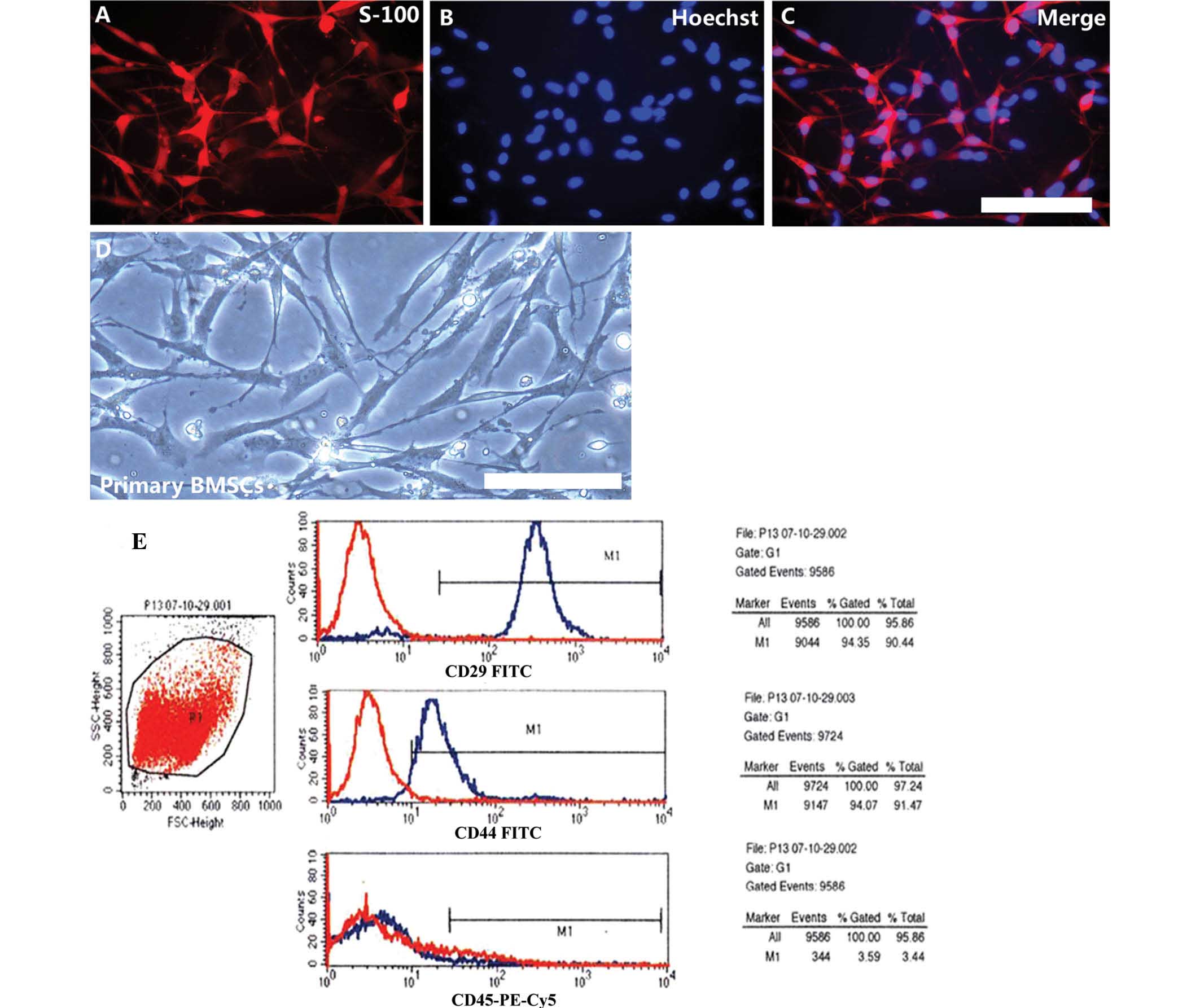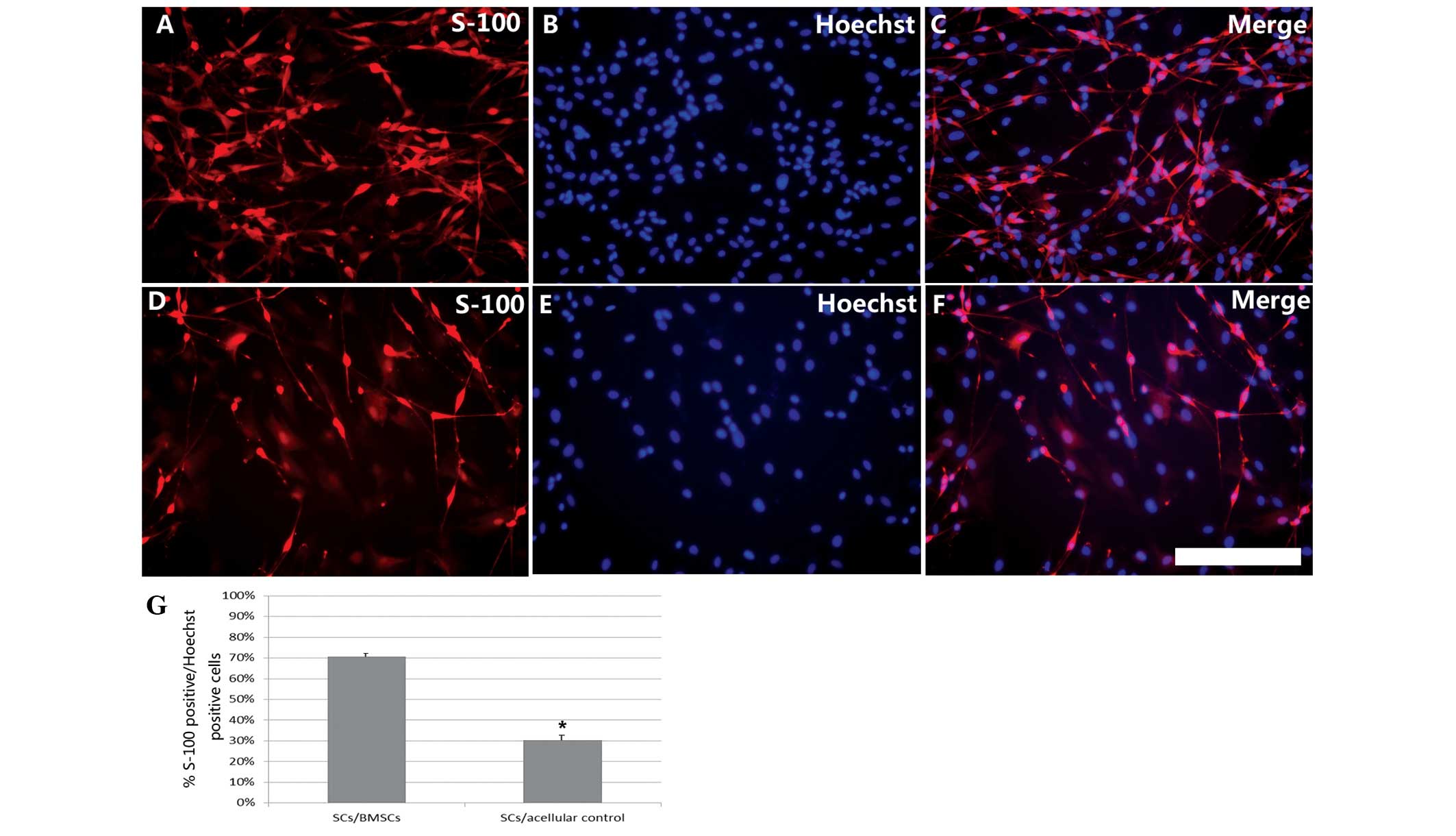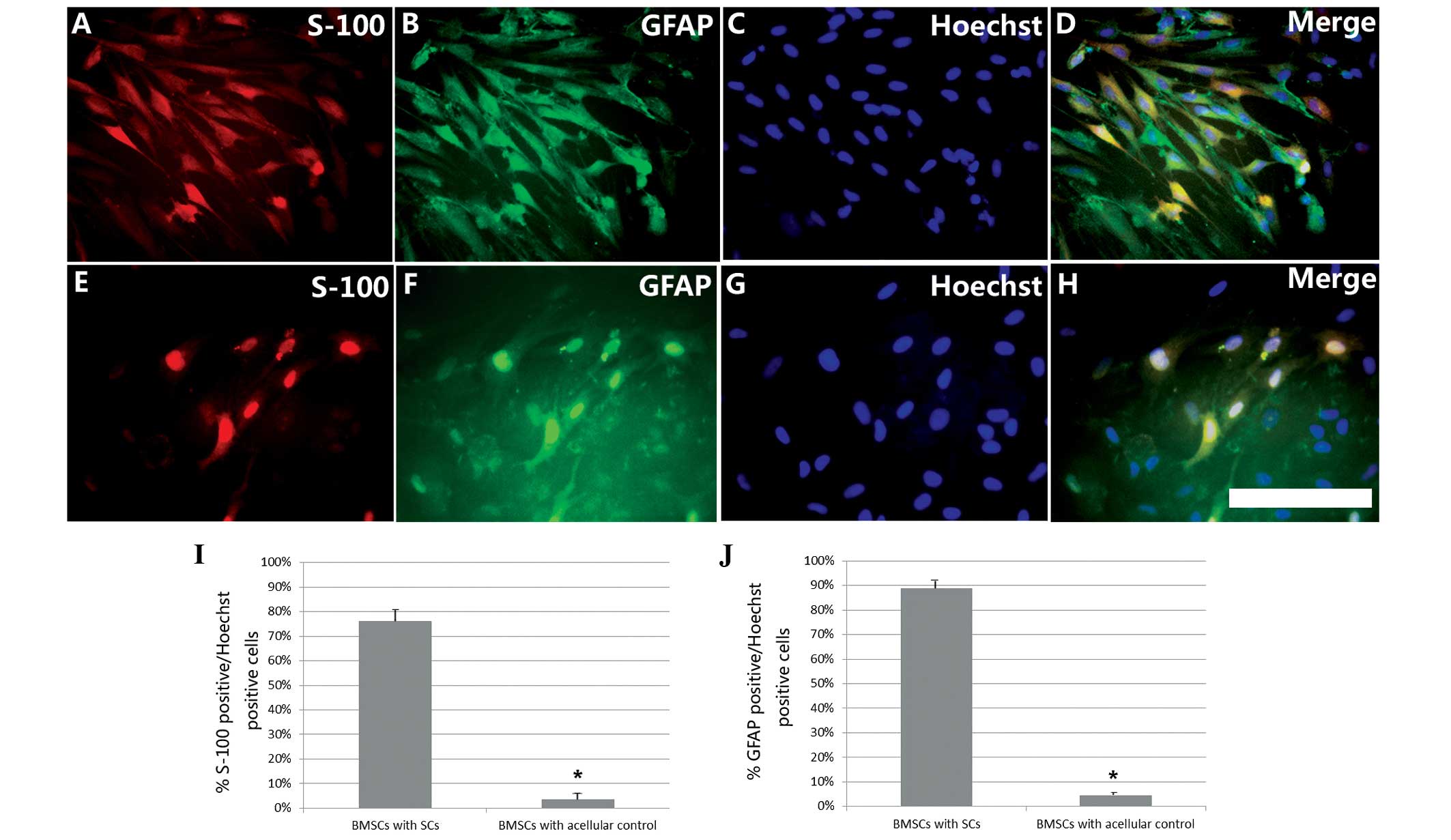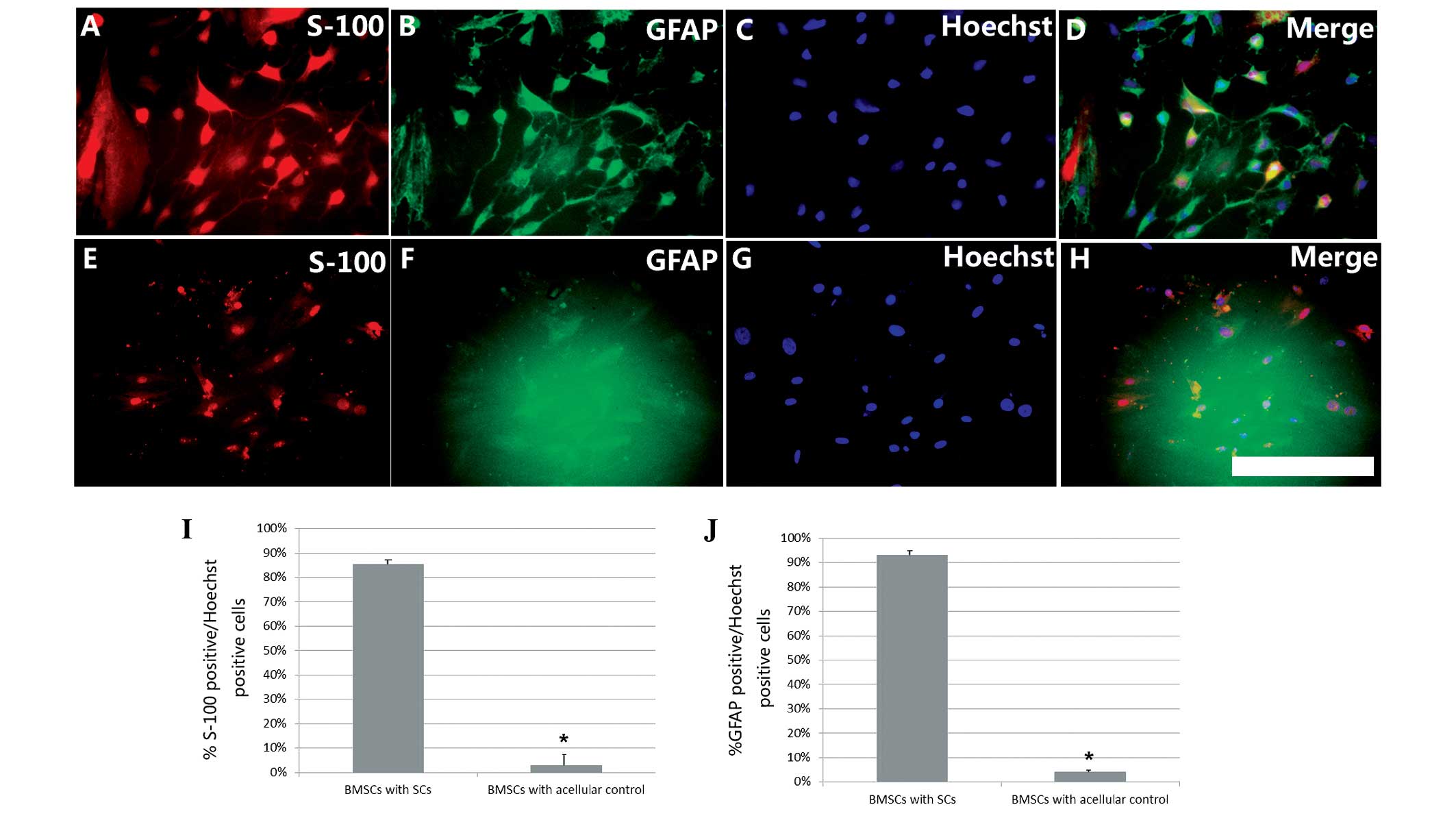|
1
|
Bunge RP: The role of the Schwann cell in
trophic support and regeneration. J Neurol. 242(Suppl 1): S19–S21.
1994. View Article : Google Scholar : PubMed/NCBI
|
|
2
|
Jessen KR and Mirsky R: Developmental
regulation in the Schwann cell lineage. Adv Exp Med Biol. 468:3–12.
1999. View Article : Google Scholar
|
|
3
|
Schlosshauer B, Müller E, Schröder B,
Planck H and Müller HW: Rat Schwann cells in bioresorbable nerve
guides to promote and accelerate axonal regeneration. Brain Res.
963:321–326. 2003. View Article : Google Scholar : PubMed/NCBI
|
|
4
|
Brenner MJ, Lowe JB III, Fox IK, Mackinnon
SE, Hunter DA, Darcy MD, Duncan JR, Wood P and Mohanakumar T:
Effects of Schwann cells and donor antigen on long-nerve allograft
regeneration. Microsurgery. 25:61–70. 2005. View Article : Google Scholar
|
|
5
|
Keilhoff G, Goihl A, Langnäse K, Fansa H
and Wolf G: Transdifferentiation of mesenchymal stem cells into
Schwann cell-like myelinating cells. Eur J Cell Biol. 85:11–24.
2006. View Article : Google Scholar
|
|
6
|
Baksh D, Song L and Tuan RS: Adult
mesenchymal stem cells: Characterization, differentiation and
application in cell and gene therapy. J Cell Mol Med. 8:301–316.
2004. View Article : Google Scholar : PubMed/NCBI
|
|
7
|
Wei Y, Gong K, Zheng Z, Liu L, Wang A,
Zhang L, Ao Q, Gong Y and Zhang X: Schwann-like cell
differentiation of rat adipose-derived stem cells by indirect
co-culture with Schwann cells in vitro. Cell Prolif. 43:606–616.
2010. View Article : Google Scholar : PubMed/NCBI
|
|
8
|
Pittenger MF, Mackay AM, Beck SC, Jaiswal
RK, Douglas R, Mosca JD, Moorman MA, Simonetti DW, Craig S and
Marshak DR: Multilineage potential of adult human mesenchymal stem
cells. Science. 284:143–147. 1999. View Article : Google Scholar : PubMed/NCBI
|
|
9
|
Ladak A, Olson J, Tredget EE and Gordon T:
Differentiation of mesenchymal stem cells to support peripheral
nerve regeneration in a rat model. Exp Neurol. 228:242–252. 2011.
View Article : Google Scholar : PubMed/NCBI
|
|
10
|
Phinney DG, Kopen G, Isaacson RL and
Prockop DJ: Plastic adherent stromal cells from the bone marrow of
commonly used strains of inbred mice: Variations in yield, growth,
and differentiation. J Cell Biochem. 72:570–585. 1999. View Article : Google Scholar : PubMed/NCBI
|
|
11
|
Azizi SA, Stokes D, Augelli BJ, DiGirolamo
C and Prockop DJ: Engraftment and migration of human bone marrow
stromal cells implanted in the brains of albino rats-similarities
to astrocyte grafts. Proc Natl Acad Sci USA. 95:3908–3913. 1998.
View Article : Google Scholar
|
|
12
|
Deng W, Obrocka M, Fischer I and Prockop
DJ: In vitro differentiation of human marrow stromal cells into
early progenitors of neural cells by conditions that increase
intracellular cyclic AMP. Biochem Biophys Res Commun. 282:148–152.
2001. View Article : Google Scholar : PubMed/NCBI
|
|
13
|
Sanchez-Ramos J, Song S, Cardozo-Pelaez F,
Hazzi C, Stedeford T, Willing A, Freeman TB, Saporta S, Janssen W,
Patel N, et al: Adult bone marrow stromal cells differentiate into
neural cells in vitro. Exp Neurol. 164:247–256. 2000. View Article : Google Scholar : PubMed/NCBI
|
|
14
|
Woodbury D, Schwarz EJ, Prockop DJ and
Black IB: Adult rat and human bone marrow stromal cells
differentiate into neurons. J Neurosci Res. 61:364–370. 2000.
View Article : Google Scholar : PubMed/NCBI
|
|
15
|
Lu L, Chen X, Zhang CW, Yang WL, Wu YJ,
Sun L, Bai LM, Gu XS, Ahmed S, Dawe GS, et al: Morphological and
functional characterization of predifferentiation of myelinating
glia-like cells from human bone marrow stromal cells through
activation of F3/Notch signaling in mouse retina. Stem Cells.
26:580–590. 2008. View Article : Google Scholar
|
|
16
|
Mahay D, Terenghi G and Shawcross SG:
Schwann cell mediated trophic effects by differentiated mesenchymal
stem cells. Exp Cell Res. 314:2692–2701. 2008a. View Article : Google Scholar
|
|
17
|
Mahay D, Terenghi G and Shawcross SG:
Growth factors in mesenchymal stem cells following glial-cell
differentiation. Biotechnol Appl Biochem. 51:167–176. 2008b.
View Article : Google Scholar
|
|
18
|
Caddick J, Kingham PJ, Gardiner NJ, Wiberg
M and Terenghi G: Phenotypic and functional characteristics of
mesenchymal stem cells differentiated along a Schwann cell lineage.
Glia. 54:840–849. 2006. View Article : Google Scholar : PubMed/NCBI
|
|
19
|
Dezawa M, Takahashi I, Esaki M, Takano M
and Sawada H: Sciatic nerve regeneration in rats induced by
transplantation of in vitro differentiated bone-marrow stromal
cells. Eur J Neurosci. 14:1771–1776. 2001. View Article : Google Scholar
|
|
20
|
Wang J, Ding F, Gu Y, Liu J and Gu X: Bone
marrow mesenchymal stem cells promote cell proliferation and
neurotrophic function of Schwann cells in vitro and in vivo. Brain
Res. 1262:7–15. 2009. View Article : Google Scholar : PubMed/NCBI
|
|
21
|
Hou SY, Zhang HY, Quan DP, Liu XL and Zhu
JK: Tissue-engineered peripheral nerve grafting by differentiated
bone marrow stromal cells. Neuroscience. 140:101–110. 2006.
View Article : Google Scholar : PubMed/NCBI
|
|
22
|
Mimura T, Dezawa M, Kanno H, Sawada H and
Yamamoto I: Peripheral nerve regeneration by transplantation of
bone marrow stromal cell-derived Schwann cells in adult rats. J
Neurosurg. 101:806–812. 2004. View Article : Google Scholar : PubMed/NCBI
|
|
23
|
Cuevas P, Carceller F, Dujovny M,
Garcia-Gómez I, Cuevas B, González-Corrochano R, Diaz-González D
and Reimers D: Peripheral nerve regeneration by bone marrow stromal
cells. Neurol Res. 24:634–638. 2002. View Article : Google Scholar : PubMed/NCBI
|
|
24
|
Zhou LN, Zhang JW, Wang JC, Lei WL, Liu XL
and Zhou LH: Bone marrow stromal and Schwann cells from adult rats
can interact synergistically to aid in peripheral nerve repair even
without intercellular contact in vitro. J Tissue Eng Regen Med.
6:579–588. 2012. View
Article : Google Scholar
|
|
25
|
Zurita M, Vaquero J, Oya S, Bonilla C and
Aguayo C: Neurotrophic Schwann-cell factors induce neural
differentiation of bone marrow stromal cells. Neuroreport.
18:1713–1717. 2007. View Article : Google Scholar : PubMed/NCBI
|
|
26
|
Hu J, Zhu QT, Liu XL, Xu YB and Zhu JK:
Repair of extended peripheral nerve lesions in rhesus monkeys using
acellular allogenic nerve grafts implanted with autologous
mesenchymal stem cells. Exp Neurol. 204:658–666. 2007. View Article : Google Scholar : PubMed/NCBI
|
|
27
|
Wang D, Liu XL, Zhu JK, Jiang L, Hu J,
Zhang Y, Yang LM, Wang HG and Yi JH: Bridging small-gap peripheral
nerve defects using acellular nerve allograft implanted with
autologous bone marrow stromal cells in primates. Brain Res.
1188:44–53. 2008. View Article : Google Scholar
|
|
28
|
Akiyama Y, Radtke C, Honmou O and Kocsis
JD: Remyelination of the spinal cord following intravenous delivery
of bone marrow cells. Glia. 39:229–236. 2002. View Article : Google Scholar : PubMed/NCBI
|
|
29
|
Dezawa M, Kanno H, Hoshino M, et al:
Specific induction of neuronal cells from bone marrow stromal cells
and application for autologous transplantation. J Clin Invest.
113:1701–1710. 2004. View Article : Google Scholar : PubMed/NCBI
|
|
30
|
Lin CH, Cheng FC, Lu YZ, Chu LF, Wang CH
and Hsueh CM: Protection of ischemic brain cells is dependent on
astrocyte-derived growth factors and their receptors. Exp Neurol.
201:225–233. 2006. View Article : Google Scholar : PubMed/NCBI
|
|
31
|
Chen CJ, Ou YC, Liao SL, Chen WY, Chen SY,
Wu CW, Wang CC, Wang WY, Huang YS and Hsu SH: Transplantation of
bone marrow stromal cells for peripheral nerve repair. Exp Neurol.
204:443–453. 2007. View Article : Google Scholar : PubMed/NCBI
|
|
32
|
Weimann JM, Charlton CA, Brazelton TR,
Hackman RC and Blau HM: Contribution of transplanted bone marrow
cells to Purkinje neurons in human adult brains. Proc Natl Acad Sci
USA. 100:2088–2093. 2003a. View Article : Google Scholar
|
|
33
|
Weimann JM, Johansson CB, Trejo A and Blau
HM: Stable reprogrammed heterokaryons form spontaneously in
Purkinje neurons after bone marrow transplant. Nat Cell Biol.
5:959–966. 2003b. View
Article : Google Scholar
|
|
34
|
Chopp M and Li Y: Treatment of neural
injury with marrow stromal cells. Lancet Neurol. 1:92–100. 2002.
View Article : Google Scholar
|
|
35
|
Lee AC, Yu VM, Lowe JB III, Brenner MJ,
Hunter DA, Mackinnon SE and Sakiyama-Elbert SE: Controlled release
of nerve growth factor enhances sciatic nerve regeneration. Exp
Neurol. 184:295–303. 2003. View Article : Google Scholar : PubMed/NCBI
|
|
36
|
Marcol W, Kotulska K, Swiech-Sabuda E,
Larysz-Brysz M, Gołka B, Górka D and Lewin-Kowalik J: Regeneration
of sciatic nerves of adult rats induced by extracts from distal
stumps of pre-degenerated peripheral nerves. J Neurosci Res.
72:417–424. 2003. View Article : Google Scholar : PubMed/NCBI
|
|
37
|
Neuhuber B, Timothy Himes B, Shumsky JS,
Gallo G and Fischer I: Axon growth and recovery of function
supported by human bone marrow stromal cells in the injured spinal
cord exhibit donor variations. Brain Res. 1035:73–85. 2005.
View Article : Google Scholar : PubMed/NCBI
|














